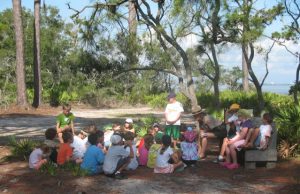
Years ago, I helped a National Park Ranger at Gulf Islands National Seashore run several “Junior Ranger” day camps in the summer. Kids went on hikes, caught crabs in dip nets, and learned about the area’s history. One of their favorite activities was a scavenger hunt of sorts. Ranger Amanda started the hike by passing out paint chip samples from a home improvement store in every color of the rainbow. Campers held bright orange, purple, yellow, and red cards in hand, and were instructed to find a color that matched theirs with something natural along the trail. In the oak hammocks of coastal Florida, you would expect plenty of greens and browns, with the occasional bright colors if flowers are in bloom. But I was delightfully surprised that during all these hikes, children scoured the trails and found matching mushrooms, insects, soil, or lichens that paired with every color they held. It was a simple yet highly effective way to engage the kids while hiking–giving them a “mission” and encouraging them to really look and make observations about the world around them.

On a recent hike, if I had been holding a bubble gum pink paint chip I could have matched it perfectly. On multiple trees, I noticed circular lichens outlined in hot pink. Most lichens around here are green and gray, so the touch of Pepto Bismol in the middle of the woods was a bit of a surprise. This particular crustose lichen has been nicknamed a “Christmas wreath” lichen (Cryptothecia rubrocinta), because the greenish inside is outlined in reddish pink. The species name rubrocinta can be translated from Latin to “red-wreathed” or “red-girdled.” The pink coloration is formed by a chemical called chiodectonic acid, which provides some protection from herbivory and UV light. The colorful chemical is used in South America to make a dye. Christmas wreath lichens grow well in sandy, acidic soils and with enough sunlight to reach the lichen. A University of Wisconsin biologist visiting the Gulf Coast noted seeing more of this species near open patches of trees surrounded by palmettos, which is exactly where I found it.

There are at least 3,600 known lichen species in North America, and 15,000 worldwide. These interesting organisms seem like plants, but are not—they have no roots, leaves, or stems. Instead, lichens are composed of a symbiotic interaction between algae and fungi. The relationship is dominated by the fungus, which provides most of the physical structure of the lichen, while the algae—typically green algae or blue-green cyanobacteria—photosynthesize and provide nutrients and sugars to the fungus, allowing the lichen to spread. Even though lichens are composed of a partnership between organisms in two of three potential taxonomic kingdoms (fungi and protist or plant), lichens are conventionally categorized as fungi since the fungus is the primary partner.
Lichens play a particularly interesting and helpful role for environmental toxicologists. Due to their absorption capabilities, they can pull in heavy metals and other pollutants from the atmosphere. When sampled, scientists can use the toxin levels in lichens to diagnose the surrounding air quality. A United States Forest Service database with records back to the 1970’s plays an important role in tracking and monitoring the impacts of pollution throughout the country.
 6
6
